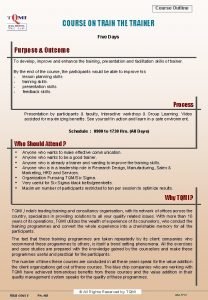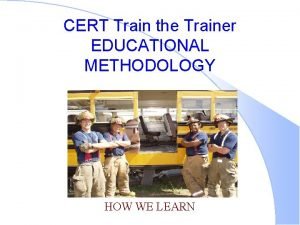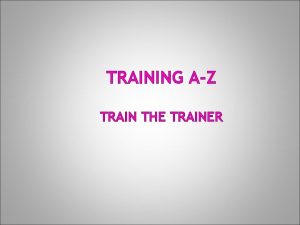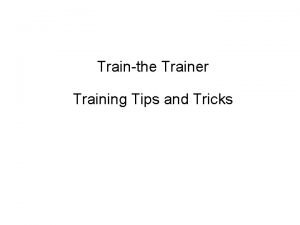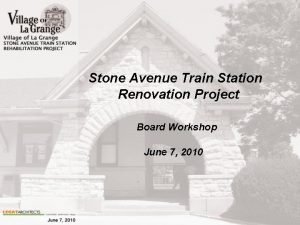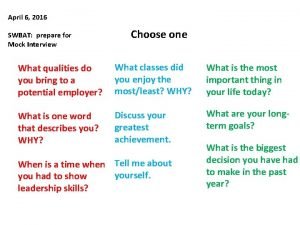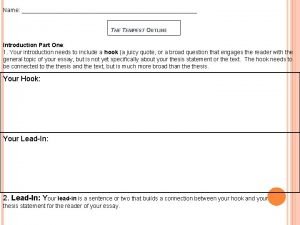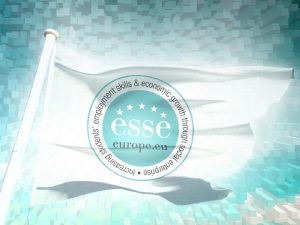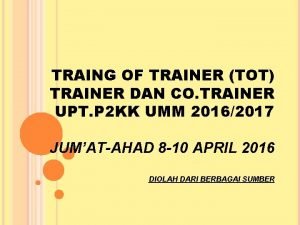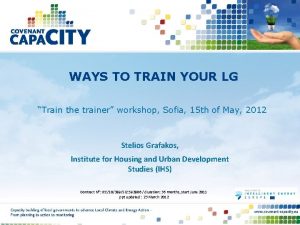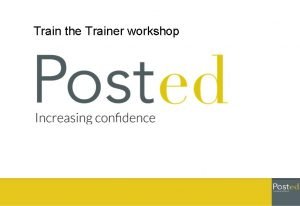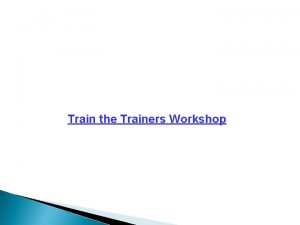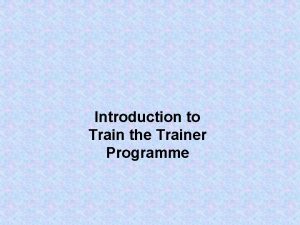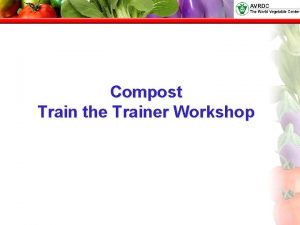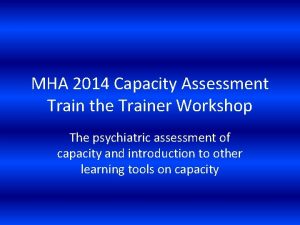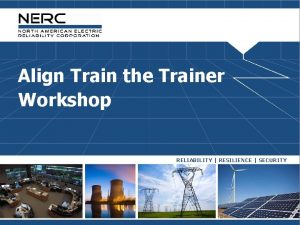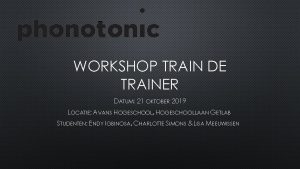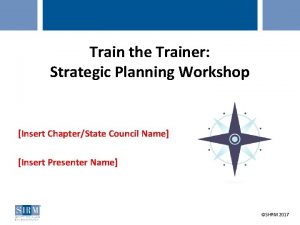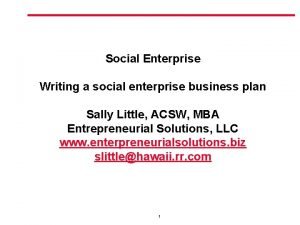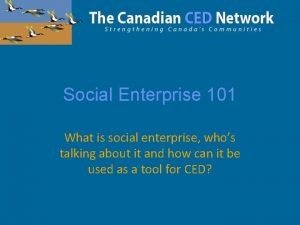Social Enterprise Train the Trainer Workshop Outline Part































- Slides: 31


Social Enterprise Train the Trainer

Workshop Outline Part 1: Getting to Know Social Enterprise Part 2: Developing Understanding Part 3: Design Thinking Part 4: Application and Evaluation

Bingo

Two Truths and a Lie • Write down three quite interesting things about you, two of which are true and one a lie. Make the lie believable. • The rest of the group have to spot the lie.

Part One Getting to Know Social Enterprise

TASK 1. Create a flipchart listing your experience of Social Enterprise (SE). 2. What is SE? Write your definition. •

Defining Social Enterprises are businesses that trade to tackle social problems, improving communities, people’s life chances or the environment. They make their money from selling goods and services in the open market, but they reinvest their profits back into the business or the local community. Social Enterprise UK 2015

Defining Social Enterprise Source: European Commission

Social Enterprise Examples

Part Two Developing Understanding

Thinking about what SE can do for our world

TASK How could SE change our world?

TASK Choose one of the SEs on the ESSE Best Practice page http: //esseeurope. eu • What is their social purpose? • How do they generate income? Social Enterprises are businesses with a social purpose. This means their activities must generate income.

Investment: Getting Started Most entrepreneurs, social or otherwise, start with very little money. They use the resources they have available to try things out and build their business idea gradually Some ways to access funding. . . • Small grants • Social Enterprise start up support • Crowdfunding

Funding and Finance: More Information • http: //www. socialenterprise. org. uk/advice-services/topic/finance • http: //www. theguardian. com/social-enterprisenetwork/2014/feb/10/how-to-guide-funding-your-socialenterprise • http: //www. businesszone. co. uk/do/people/the-ultimate-guide-toraising-finance-for-a-social-enterprise

Social Enterprise Quiz. . . put your notes away

Coming up next… • Creative design thinking • Applications of learning Over lunch, think about issues you would like to address using a social enterprise approach

Part Three Design Thinking

Creative Thinking Design a test for the idea Select the best idea Brainstorm ideas Form insights about the users Describe the potential users Initial SE ideas or scenarios

Step 1: identify potential SE business ideas Suggested scenarios Example 1: Personal transport solutions for adults with very limited budgets. Example 2: A new kind of holiday for people on low incomes. Example 5: Opportunities for young people who say they can’t afford to leave their family home. Example 3: An online store and app to buy ecofriendly products. Example 4: A new kind of affordable hairdressing salon and/or barbers.

Step 2: describe the customers or clients Describe the customers or clients for this business – what they do, what they need, how they live etc. Do not interpret this – merely describe or make observations. Focus on extreme users NB: the reason why we focus on extreme users is that they tell us more about the service or product and how it/they are used - it brings out more than would be seen observing standard customers or users.

Step 3: form insights Consider the motivations, thoughts and values of the users, customers or clients. Select insights based on their ability to reveal how people think or feel. Rate the insights: (number one is highest or best).

Step 4: brainstorm and visualise ideas Select your top insights from the previous task (no more than three). Using these insights, brainstorm products or services to meet the customers’ needs and serve a social or environmental purpose. Note: When you brainstorm the ideas, defer judgement, encourage wild ideas and lots of ideas; visualise (sketch) and build on others’ ideas.

Step 5: each group selects the best idea. . . the one that is the most inspirational, meets a real need or solves a real problem and is relevant to the original idea of a SE business.

Step 6: devise a simple storyboard to explain the SE idea and see if it is both workable and beneficial. Storyboard The current situation or the problem Our idea How it can make money Benefits for the How this SE will people affected improve the world

Sharing ideas Each group briefly presents: • How they arrived at their chosen idea • Overview of the idea • The experiment to test if it works Our idea!

Part Four Application and Evaluation

Reflection and Application Work in pairs. Write the answers on post-its • • What have you learned? Any questions remaining? Where will you use what you have learned? What is my first step? (keep this one)

Resources and Support Starting a social enterprise in Plymouth: http: //plymsocent. org. uk/start-a-socialenterprise-in-plymouth/ The ESSE community: http: //esseeurope. eu/

Evaluation
 Train the trainer course outline
Train the trainer course outline Train the trainer course objectives
Train the trainer course objectives Cert train the trainer
Cert train the trainer Train the trainer agenda
Train the trainer agenda Train the trainer tips and tricks
Train the trainer tips and tricks Stone avenue train station
Stone avenue train station Mock interview workshop outline
Mock interview workshop outline Putting the enterprise into the enterprise system
Putting the enterprise into the enterprise system Putting the enterprise into the enterprise system
Putting the enterprise into the enterprise system What is sentence outline
What is sentence outline Social thinking and social influence
Social thinking and social influence Social thinking social influence social relations
Social thinking social influence social relations Is ap research worth it
Is ap research worth it What is the name of the first part of an outline?
What is the name of the first part of an outline? Hình ảnh bộ gõ cơ thể búng tay
Hình ảnh bộ gõ cơ thể búng tay Slidetodoc
Slidetodoc Bổ thể
Bổ thể Tỉ lệ cơ thể trẻ em
Tỉ lệ cơ thể trẻ em Gấu đi như thế nào
Gấu đi như thế nào Chụp phim tư thế worms-breton
Chụp phim tư thế worms-breton Chúa yêu trần thế alleluia
Chúa yêu trần thế alleluia Các môn thể thao bắt đầu bằng tiếng chạy
Các môn thể thao bắt đầu bằng tiếng chạy Thế nào là hệ số cao nhất
Thế nào là hệ số cao nhất Các châu lục và đại dương trên thế giới
Các châu lục và đại dương trên thế giới Công thức tính thế năng
Công thức tính thế năng Trời xanh đây là của chúng ta thể thơ
Trời xanh đây là của chúng ta thể thơ Mật thư tọa độ 5x5
Mật thư tọa độ 5x5 Phép trừ bù
Phép trừ bù độ dài liên kết
độ dài liên kết Các châu lục và đại dương trên thế giới
Các châu lục và đại dương trên thế giới Thơ thất ngôn tứ tuyệt đường luật
Thơ thất ngôn tứ tuyệt đường luật Quá trình desamine hóa có thể tạo ra
Quá trình desamine hóa có thể tạo ra
